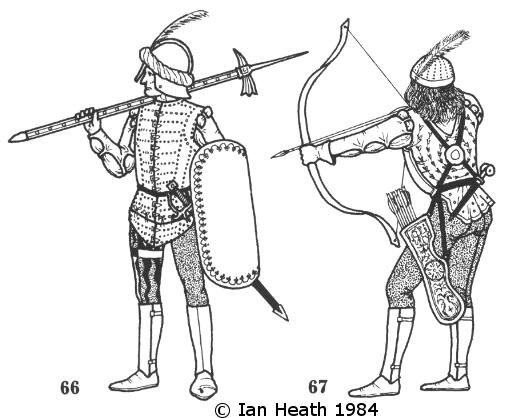Join Amazon Prime - Watch Thousands of Movies & TV Shows Anytime - Start Free Trial Now Amazon Audible Gift Memberships |
 | |
VENETIAN FOOT-SOLDIERS c.1490
An extract from Armies of the Middle Ages, Volume 2by Ian Heath
Join Amazon Prime - Watch Thousands of Movies & TV Shows Anytime - Start Free Trial Now Amazon Audible Gift Memberships |
 | |
66 & 67. VENETIAN FOOT-SOLDIERS c.1490
These figures, from episodes of Carpaccio’s ‘St Ursula’ cycle of paintings dating to 1490 and 1493, depict Venetian equipment typical of the period 1460-1500. Figure 66 wears a brigandine (corazzina), greaves (schinieri) and celata, while 67 substitutes a breastplate (corazza) and a red, plate-lined cap called a beretta di piastre. Others wear the brigandine over a mail corselet, but that is about as heavy as their equipment seems to have normally got. Arms included pikes, polearms, crossbows and composite bows. The last are to be found in a great many Italian, and particularly Venetian, pictures of the 15th century, the adoption of this weapon on such an unprecedented scale doubtless resulting from Venice’s trading links with and territorial possessions in the Balkans and the Near East. Indeed, composite bows (called ‘Turkish bows’) appear to have heavily outnumbered crossbows in Venetian military service at this date; significantly the contemporary woodcut of the Battle of Zonchio (1499) shows 6 composite bows and even 3 handguns amongst the Venetian seamen, but only 2 crossbows. Note also the yellow leather Turkish-style quiver (turcassa see note to figures 1 and 2). Another weapon introduced from the Balkans was the schiavona or Slavonic sword, worn by 66, which was identifiable by its horizontally curved hilt, by this late date accompanied by a knuckle-guard that was lacking from earlier examples. The stradiot sword (spada alla stradiotta) was probably this type of weapon. His main weapon is a war-hammer.
Other Venetians, including men-at-arms, would have been indistinguishable from the Italians depicted in volume 1.
[Helmet, war-hammer and sleeves of 66 based on the middle ground figure in "Pilgrims’ Arrival in Cologne", the Life of St Ursula, by Vittore Carpaccio, 1490-96
Red armour of 66 based on figure in right foreground in "Pilgrims’ Arrival in Cologne", the Life of St Ursula, by Vittore Carpaccio, 1490-96
Shield and hose of 66 based on the "Martyrdom of the Pilgrims", the Life of St Ursula, by Vittore Carpaccio, 1490-96
67 based on the foreground archer in "Martyrdom of the Pilgrims", the Life of St Ursula, by Vittore Carpaccio, 1490-96]